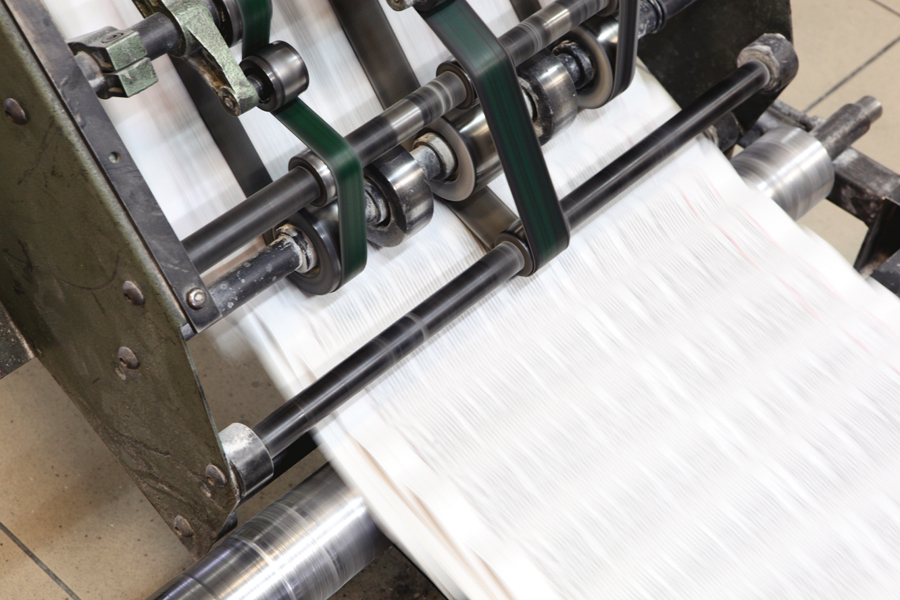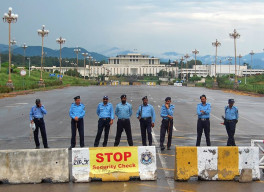
On the opposite side of the cluttered table, his Hyderabadi wife, Anjum Khalil, patiently sifts through sheets of printed Urdu stories and scratches out and re-writes sentences. Old issues of newspapers, a few pens and highlighters, calendars and other office supplies lay carelessly strewn over the L-shaped desk setup, surrounded by four chairs and two desktops. A handful of overhanging wires connecting the computers with a router, scanner, fax-machine and printer dangle from various shelves and walls, giving the place an almost warehouse-like feeling. This is the New York newsroom of the oldest and largest weekly Urdu language newspaper, The Urdu Times. Run by the husband-wife duo, this Pakistani weekly is the most widely read Urdu language newspaper in North America and has 14 print and online editions in the United States, Canada and Britain. It also enjoys the largest circulation for an Urdu paper outside of Pakistan, according to its owners. And the paper’s free availability makes it even more unusual compared to other publications.

To keep up with a rapidly evolving news market, Khalil has also set up a website which allows him to cater to a wider audience. PHOTOS: PURVI THACKER
Le(a)ding the market
Raised in Islamabad by an upper-middle class family, Khalil says he had “no real job” before he migrated abroad. “It was around 1979 and I worked in the floor covering or carpet business,” he reminisces. “I had no intention of publishing or doing any newspaper business.” His trajectory from an odd-job immigrant to the founder, editor and publisher of The Urdu Times has been remarkable for someone without any journalism background or publishing infrastructure.
At the time, Indian immigrants in New York had started publishing newspapers centred on South Asian news, which usually had a negative angling towards Pakistan. “Now I am a liberal person, but misrepresenting my homeland and community is not justified,” he says. He also recalls that during the 1980s there was a vacuum in the market for Pakistan-centric news. Both reasons spurred him to start his own newspaper, The Eastern Times, an English language weekly, as there was no typesetting or calligraphy for Urdu at the time. The paper eventually folded, but Khalil had set the wheels in motion. He had single-handedly “self-taught and self-made” a publishing business, in an environment where he had to rely on borrowed teleprinters from the Pakistani consulate.

The New York newsroom for The Urdu Times where news is procured from various sources and reworked for a Pakistani American audience. PHOTOS: PURVI THACKER
This venture eventually paved way for The Urdu Times in 1991, at a time when there was a dearth of Urdu journalism. “I moved shop from Manhattan to Jamaica, Queens, and stopped carrying bags containing sheets and rolls of faxed news from the Pakistani consulate,” he explains. Instead he started toying with existing technology to get him his news. With his number 286 basic computer, he managed to churn out stories for the tabloid-sized Urdu publication from Pakistani newspapers and utilised the then newly developed 12-point font Urdu typecast and stencils for headlines. Every week he booked a call to Lahore, where he would have had someone record five or six Urdu stories emerging from the local media and phone record the clips. He would then transcribe those stories, develop new angles and re-write them. “My subject matter was anything to do with Pakistan, South Asia and Muslims,” he says. He would then distribute these papers in a bookstore that existed by Grand Central (now by the MetLife building) in Manhattan. With a staff of 18, consisting of four typists, he tried to sell the paper, but with scant luck. With limited Urdu newspaper readers in the community, who didn’t fully understand the business or anything about local advertising, Khalil had no other choice but to make his paper available for free so he could improve readership.

Khalilur Rehman and his wife Anjum Khalil, the duo behind The Urdu Times, the most widely read Urdu weekly newspaper in North America. PHOTOS: PURVI THACKER
The Big (B)ad world
For Khalil, combining passion with technological advances was one thing, but using his entrepreneurial judgment to sustain the business was the need of the hour. Post-1995, the newspaper market expanded due to the rising number of Pakistani immigrants to the United States. Using the budding community as a resource, Khalil started procuring local advertisements ranging from halal meat in ethnic grocery stores, local South Asian travel agencies advertising for Haj, to Islamic community centre ads. He slowly progressed onto corporate ads, which consisted of Western Union money transferring, long-distance phone cards and cell phone ads. The engineers and doctors in the Pakistani community were prospering, and so local business advertisements also proved to be lucrative.

Khalil’s team in Lahore sends him a selection of daily news which he then uses his editorial judgement to pick, angle and handwrite into an article. The articles are then scanned and sent back to Lahore where they are typed out and resent to Khalil. The final assembled paper is then sent to a printer in Long Island City. PHOTOS: PURVI THACKER
“Corporate ads brought in some decent revenue and our position as the only Urdu language paper appealed to the community,” he says. For the non-computer savvy older immigrant community that was used to reading Urdu papers, The Urdu Times served as a dual resource — for them to get news in their mother tongue from Pakistan along with staying updated with the local happenings and deals in New York.

Old editions of the newspaper can be found at their office in the form of hard copies. PHOTOS: PURVI THACKER
Muhammed Farooqi was appointed editor of The Urdu Times, just when Khalil moved to Jamaica, Queens. But soon, he too realised that it was important for the community to get a taste of the day-to-day issues and incorporate hyper local elements. To fill that gap, he started The Pakistan Post, which focused on in-depth, long form community-centric news. “For the older generation, reading a newspaper is a basic, it is a necessity,” he explains.
While Farooqi and Khalil have long since consolidated and set a standard advertising rate so that both papers can mutually coexist, other small-time Urdu papers have sprung up to contend within the South Asian community, which has caused a divide in advertising revenue. Both, The Pakistan Post and The Urdu Times can be found stacked side by side atop racks at several of the city’s community newspaper distribution spots, but often smaller Pakistani weeklies will be strategically moved to the top. Popular spots of distribution are outside mosques, community centres, South Asian grocery stores and ethnic neighbourhoods like Jackson Heights, Murray Hill and even outside the Empire State building.
Overseas sources, local angle
Both papers have moved their major operations to offices in Lahore. This outsourcing has been strategically done in keeping with the rising costs and lowering readership. “Do you know that one man’s payroll here covers the cost of employing four people in Pakistan,” explains Khalil. He says he made the conscious decision of hiring a 10-man team in Lahore, simply because it was more economical to cover staff as well as printing and production expenses.

Free copies of The Pakistan Post and The Urdu Times can be found on various street corners in Queens and Manhattan. PHOTOS: PURVI THACKER
His crew in Lahore usually sends him a selection of daily news, which he then uses his editorial judgment to pick, angle and handwrite into an article. “I pay heed to the American point of view and what my community here would want to hear,” he says. The articles are then scanned and sent to Lahore where they are typed out, sent back and reworked before Khalil and his wife send in the final pages for layout and graphics back to Lahore. The assembled product is then given to Linco Printers based in Long Island City. This process is repeated weekly and both of them even work through the weekend. “I don’t even know what a Sunday is anymore,” his wife admits.
Farooqi follows a similar pattern of PDF, e-faxing and proof reading. “I am the biggest labourer in my office,” he jokes.
The Urdu Times also has its share of regular columnists and contributors in every city where it is distributed. Professors, students, community leaders and even one-off writers vie to send in a piece. “Look, our contributors do this purely out of passion, we hardly pay them more than $150 a month, so there are minimal op-eds or original content,” says Khalil. He mentions an older gentleman in New York who provides a nazam (poem) on current affairs every week.

Imran, a Pakistani American, skims through the classified section of The Urdu Times. The paper enjoys a large readership in the New York desi community. PHOTOS: PURVI THACKER
The newspaper’s burgeoning readership across cities such as New York, Washington DC, Miami, Los Angeles, Houston, Dallas, Chicago, Atlanta, Toronto, Bradford, Montreal, Manchester and Birmingham is a testimony to its outreach and influence. While the paper’s Toronto and London office have a staff of 10 each, most of the American office branches don’t have more than a team of two. “Our Canada and UK issues are flourishing,” he says. Hence, there are more pages in their issues as compared to New York. Khalil is blatant about the fact that “ads are the master” for a market like New York where circulation is estimated to be around 15,000 copies weekly. Sometimes if there are more classifieds (featuring property and rent ads or marriage ads), the pages can even go up to 16 or 17. Canada, on the other hand usually has an issue of 25 pages as the city pages featuring community-centric events and news are far more popular than the international news items.
All 14 editions of The Urdu Times are scanned and posted online as PDF versions. While the front page lead story for each issue is the same, because it is usually an international news item, a marked difference when comparing issues online are the changes in advertisements on the cover page and minor headline alterations, which cater to the local audience in each country. The masthead also remains uniform, with changes to the flag, depending on the country of issue.
A digital future
To keep up with the pressures of a rapidly evolving news market, Khalil has started a website that “puts all the news under one head”. He admits that it has become more about survival in such a struggling market and feels that the other 10 to 12 Urdu language papers are also ailing under the staggering pressure of digital and online world of news. “My wife is my biggest anchor and it is only two of us here in New York who are sailing this ship,” he says. His long-term vision is to develop a site with daily news updates or “pure news” and then devise various regional and hyper local verticals. “I want it to be like BBC Urdu and VICE.”
Farooqi concurs with the demand for online news, but feels that language-oriented newspapers have a bigger chance of surviving in a declining print market vis-a-vis English papers, which he feel are “already finished.”
Khalil has even incorporated the naskh script from the existing nastaliq script in an attempt to keep up with the recent changes made to the Urdu script and make it more searchable for mobile devices and the web. The nastaliq script is more cursive and ornate, and is still used in The Urdu Times, whereas the naskh script is more angular and straight. “My print reader is confused with this change, but it’s something they have to get used to. Anyways I am only giving myself another 10 to 15 years in this business,” he says.
The fax machine starts beeping and Khalil calls for his marketing manager. “Right now, this man is the most important part of my business,” he playfully adds as he archives yet another old issue in a back room where years of history lies stringed together in yellowing pages.
Purvi Thacker is a graduate from the Columbia Journalism School and currently works as a freelance journalist in New York. She tweets @purvi21.
Published in The Express Tribune, Sunday Magazine, April 20th, 2014.
COMMENTS (2)
Comments are moderated and generally will be posted if they are on-topic and not abusive.
For more information, please see our Comments FAQ



1731975305-0/Untitled-design-(40)1731975305-0-165x106.webp)
1731975060-0/Untitled-design-(39)1731975060-0-165x106.webp)





1731929357-0/Express-Tribune-(6)1731929357-0-270x192.webp)






Wonderful story. Congratulations to Purvi Thacker and to the newspaper for publishing it. For years, I have off and on seen the website of this US-based Urdu newspaper. Someone needed to tell the story, and you have done it very well.
The article has brilliantly brought out the industrious and hardworking gene in the us citizens of Asian origin.The writer has literally crafted a biography on the newspaper in the us ,garnished by apt pictures.The article is crisp and has brought out the facts with a blend of classic prose and modern lingo. Kudos